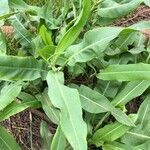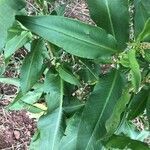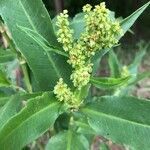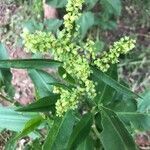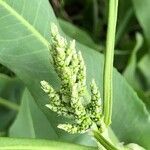Plants perennial, glabrous, with vertical rootstock. Stems erect, rarely ascending, usually pro-ducing axillary shoots below 1st-order inflorescence or at proximal nodes, 50-90(-120) cm. Leaf blades ovate-lanceolate, elliptic-lanceolate, or lanceolate, 10-15 × 3-5.5 cm, usually ca. 2.5-4 times as long as wide, widest in proximal 2, thick, often subcoriaceous, base broadly cuneate, rarely almost rounded, margins entire, flat, apex acute or attenuate. Inflorescences terminal and axillary, terminal usually occupying distal 1/5-3 of stem, rather dense, normally broadly paniculate. Pedicels articulated in proximal 1/ 3, sometimes almost near base, thick, (2-)3-7(-8) mm, usually approximately as long as inner tepals, occasionally slightly longer or shorter, articulation swollen. Flowers 12-20 in whorls; inner tepals with broadly triangular, ovate-triangular, or broadly ovate-deltoid, 4.5-6 × 3-4.5(-5) mm, base truncate or indistinctly cordate, margins entire, apex acute; tubercles (2-)3, equal or subequal, glabrous or minutely rugose. Achenes brown or dark reddish brown, 2.5-3.5 × 1.8-2.3 mm. 2n = 20.
More
Stout perennial to 1 m, often branched; lvs all cauline, pale, flat, lanceolate or more often lance-ovate, acute or acuminate, obtuse or rarely rounded at base; infl loose, 1–3 dm, with usually few short ascending branches; pedicels 3–5 mm, jointed just above the base; valves firm, subrotund, 4–6 mm long and wide, broadly truncate at base; grains 1–3, when plural often unequal, the larger lanceolate, acute, half to two-thirds as long as the valve; 2n=20. Swamps and wet soil; N.H. to Mich., Minn., and Colo., s. to Va., Ga., Tex., and Ariz.
